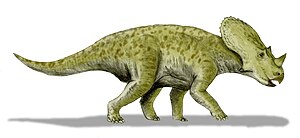Brachyceratops
| Brachyceratops | ||||||||||||
|---|---|---|---|---|---|---|---|---|---|---|---|---|

Live reconstruction of Brachyceratops |
||||||||||||
| Temporal occurrence | ||||||||||||
| Upper Cretaceous (late Campanium ) | ||||||||||||
| 76.4 to 72 million years | ||||||||||||
| Locations | ||||||||||||
|
||||||||||||
| Systematics | ||||||||||||
|
||||||||||||
| Scientific name | ||||||||||||
| Brachyceratops | ||||||||||||
| Gilmore , 1914 | ||||||||||||
| Art | ||||||||||||
|
||||||||||||

Brachyceratops is a genus of pelvic dinosaurs from the group of Ceratopsidae within the Ceratopsia .
features
From brachyceratops only the remains poorly preserved juveniles are known to date. These reached a length of almost 2 meters, the size of the adult animals is not known. The skull had a short, thick horn on its nose, and above the eyes, as is usual with the Centrosaurinae , there were bony bumps and no horns. They had a neck shield that was formed from the parietal bone and the scaled bone. Like all Ceratopsia, they were herbivores.
Discovery and naming
The fossils of brachyceratops were in the Two Medicine Formation in the State of Montana found and 1914 first described . These are the remains of several young animals, possibly siblings, that stayed together after hatching. The generic name is derived from the Greek words brachys ("short") and keratops ("horn face"). The type species is B. montanensis . The finds are dated in the Upper Cretaceous (late Campanium ) to an age of about 76 to 72 million years.
Systematics
Since only young brachyceratops are known to date , a systematic classification is difficult. The characteristics speak for an affiliation to the Centrosaurinae within the Ceratopsidae . Since the distinguishing features of the horns and neck shields in the Ceratopsidae only emerged in the adult animals, it is possible that Brachyceratops is only the young form of an already known genus. Sampson et al. therefore advocate using Brachyceratops as the nomen dubium due to the poor material .
literature
- Peter Dodson , Catherine A. Forster, Scott D. Sampson: Ceratopsidae. In: David B. Weishampel , Peter Dodson, Halszka Osmólska (eds.): The Dinosauria . 2nd edition. University of California Press, Berkeley CA et al. 2004, ISBN 0-520-24209-2 , pp. 494-513.
- ^ Gregory S. Paul : The Princeton Field Guide To Dinosaurs. Princeton University Press, Princeton NJ et al. 2010, ISBN 978-0-691-13720-9 , p. 261, online ( memento of the original from July 13, 2015 in the Internet Archive ) Info: The archive link was inserted automatically and has not yet been checked. Please check the original and archive link according to the instructions and then remove this notice. .
- ↑ Scott D. Sampson, Michael Ryan, Darren H. Tanke: Craniofacial ontogeny in centrosaurine dinosaurs (Ornithischia: Ceratopsidae): Taxonomic and behavioral implications. In: Zoological Journal of the Linnean Society. Vol. 121, No. 3, 1997, ISSN 0024-4082 , pp. 293-337, doi : 10.1111 / j.1096-3642.1997.tb00340.x .